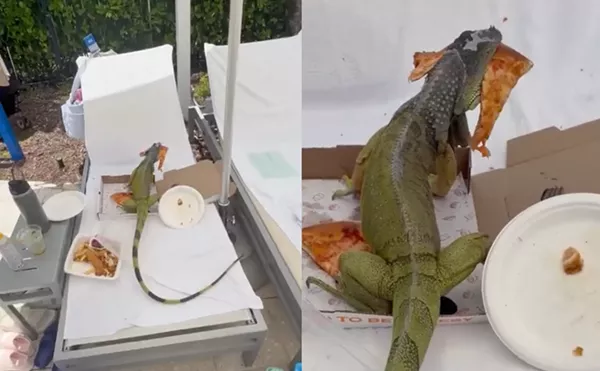We all know vegetables are good for us, but what about sea vegetables like nori, wakame, kelp, and dulse? The next time you reach for a sushi roll, keep in mind that the dark green stuff is more than just a pretty wrapper for all that sticky rice and fish. It's also packed with essential vitamins and minerals that foods grown on land -- including organic vegetables and fruits -- can't provide.
At Hippocrates Health Institute in West Palm Beach, co-directors Brian and Anna Maria Clement have implemented a wide array of sea vegetables as part of the institute's signature Life Transformation Program. This three-week-long instruction helps people enrolled in the program understand how foods can heal or aid the body in reversing the signs and symptoms of disease, including common and debilitating ailments like diabetes, cancer, muscular dystrophy, and Parkinson's, according to a raw vegan diet.
See Also:
-- Hippocrates Health Institute Serves Raw Vegan Eats
-- How To Make Your Own Raw Vegan Sushi
-- How To Grow Your Own Sprouts
-- Pond Scum Is Good For You
As part of that instruction, guests learn how to incorporate all the most nutritious foods from land, sea, and water, Hippocrates Health Institute greenhouse manager Brian Hetrich told Clean Plate Charlie during a recent interview. "That means sprouts and grasses from land, algae from our fresh waters, and sea vegetables like kelp, nori, and wakame from the oceans."
To understand why sea vegetables are an important part of the Hippocrates raw vegan diet, Hetrich explains that you must first understand why the nutrients they provide are hard to find elsewhere -- and it all starts with fertilizer. Today, most fertilizer contains a mix of nitrogen, potassium, phosphorus, sulfur, and magnesium, which are all necessary to sustain plant life. Before commercial fertilizers, plants -- our food -- received those nutrients from fallen leaves, rotten logs, dead animals, and animal waste.
However, when it comes to growing large crops (or even planting your own garden), most rely on man-made fertilizers to get the job done. Since the 1920s, these synthetic fertilizers come from natural materials but are chemically processed. For example, nitrogen comes from the air, which is treated with natural gas at a very high temperature and pressure to produce ammonia, which is made into fertilizer. Phosphorus and potassium come from mined rocks that are treated with acids and other chemicals to form granules that will dissolve and reach plant roots quickly.
While almost all synthetic fertilizers contain nitrogen, phosphorus, and potassium -- the three main elements necessary to sustain plant life -- they do not contain the trace elements our plants (and us!) need in lower or trace amounts. However, according to Hetrich, our oceans are a rich source of living plants that offer many essential nutrients and minerals that are an essential component of all therapeutic diets.
"Over the decades, commercial farming and land erosion has contributed to depleting our soils of many essential nutrients, and that means those nutrients don't make it into our foods," says Hetrich. "However, all those minerals and vitamins are in the ocean waters and part of sea vegetables. By eating them, we can help replenish many of those crucial elements we need in trace amounts that food grown on land cannot produce."Seaweed, when eaten regularly, is one of the best natural food sources of dietary iodine, and unlike fish and shellfish, it does not accumulate fat-soluble pesticides and industrial wastes. Sea vegetables are also an excellent source of vitamins and minerals, including potassium, sodium, calcium, magnesium, sulfur, nitrogen, iron, zinc, boron, copper, manganese, chromium, selenium, bromine, vanadium, and nickel. And because they are a better source of these nutrients than meat, dairy, or land-grown fruits and vegetables, they are an important part of a healthy diet to help compensate for the frequent low mineral content of food plants and animals grown "factory-style" on mineral-depleted soils, says Hetrich.
Although most of us are familiar with nori, the dark-green sheets of dried seaweed used to roll our sushi, most people are not aware of the many other sea vegetables, including dulse, kombu, and kelp. But how do you eat sea vegetables?
Sea vegetables are just an ocean-growing algae. Unlike freshwater algae, they come in many varieties and can range in color from red, brown, and blue to various shades of green. Due to their many textures and flavors, sea vegetables also make great additions to a variety of meals, including salads, soups, and sandwiches. Below, Hetrich describes Hippocrates' most popular seaweeds, including wakame and dulse.
Nori
Although this red sea alga is manufactured into dried sheets for our modern dietary consumption (mainly for sushi), nori has been eaten by indigenous peoples for centuries. Try using it to make your own sushi, and reap the health rewards. Nori is one-third protein and is high in dietary fiber. It also contains high levels of iodine, carotene, vitamins A, B and C, as well as significant amounts of calcium and iron. Although the nutritional value varies, a typical 100-gram serving of dried nori contains about 40 grams of protein, 36 grams of dietary fiber, and 3 grams of zinc.
Dulse
Also a red alga, dulse is another easy-to-eat snack. When dried, it can be eaten as a cracker-like snack but can have a strong, salty taste. It can also be eaten "wet" -- or hydrated -- in salads and soups. Raw dulse adds another dimension to any green salad with brilliant purple color and tangy salty flavor, says Hetrich. Simply tear or cut the dulse into bite-sized pieces and mix it in. Dulse is also good in soups, thanks to its rich flavor.
Kelp
Kelp, or brown alga, thrives in the fast-flowing subtidal waters, its olive-colored leaves growing as long as six feet. Kelp is best when eaten fresh, or "wet," and is loaded with vitamins and minerals, and naturally tenderizes the food it is mixed with. Throw it in a soup or salad, while roasted or dehydrated kelp can act as a crunchy garnish to top dishes like vegetable-based grains and pasta.
Kombu
Also known as Atlantic kombu, this sea vegetable is harvested from a niche ecosystem from the deepest parts of the sea, where it clings to rocks. The plants dry to a dark-green, near-black color and are loaded with minerals, vitamins, and trace elements, with especially high levels of iodine, calcium, potassium, iron, carotene, and B vitamins, to name a few. Slightly sweet, it also offers a taste of its naturally occurring sugar, manitol, and can help to dissolve mucus and regulate blood pressure.
Wakame
Wakame, or alaria, is the seaweed salad we see on Japanese restaurant menus. It grows in thick beds on low surf-battered ledges and has been shown to have high levels of fucoxanthin, which can help burn fatty tissue. It is also a rich source of eicosapentaenoic acid, an omega-3 fatty acid, and is high in calcium, iodine, thiamine, and niacin. In Oriental medicine, it has been used for blood purification, intestinal strength, skin, hair, reproductive organs, and menstrual regularity. In Korea, for example, a special wakame soup is consumed by women after giving birth to help nursing mothers fortify their first milk. Wakame is also the classic seaweed to use in miso soup.
To learn more about how to incorporate sea vegetables into your diet or to find out about the Hippocrates Health Institute signature Life Transformation Program, call Hippocrates at 888-228-1755, or visit the website.
Follow Clean Plate Charlie on Twitter @CleanPlateBPB and Nicole Danna @SoFloNicole








